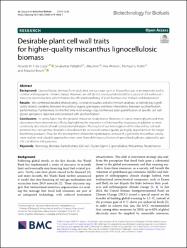Desirable plant cell wall traits for higher-quality miscanthus lignocellulosic biomass

View/
Access
info:eu-repo/semantics/openAccessDate
2019Author
da Costa, Ricardo M. F.Pattathil, Sivakumar
Avcı, Utku
Winters, Ana
Hahn, Michael G.
Bosch, Maurice
Metadata
Show full item recordCitation
da Costa, R. M. F., Pattathil, S., Avci, U., Winters, A., Hahn, M. G., & Bosch, M. (2019). Desirable plant cell wall traits for higher-quality miscanthus lignocellulosic biomass. Biotechnology for biofuels, 12, 85. https://doi.org/10.1186/s13068-019-1426-7Abstract
Background: Lignocellulosic biomass from dedicated energy crops such as Miscanthus spp. is an important tool to combat anthropogenic climate change. However, we still do not exactly understand the sources of cell wall recalcitrance to deconstruction, which hinders the efficient biorefining of plant biomass into biofuels and bioproducts. Results: We combined detailed phenotyping, correlation studies and discriminant analyses, to identify key significantly distinct variables between miscanthus organs, genotypes and most importantly, between saccharification performances. Furthermore, for the first time in an energy crop, normalised total quantification of specific cell wall glycan epitopes is reported and correlated with saccharification. Conclusions: in stems, lignin has the greatest impact on recalcitrance. However, in leaves, matrix glycans and their decorations have determinant effects, highlighting the importance of biomass fine structures, in addition to more commonly described cell wall compositional features. the results of our interrogation of the miscanthus cell wall promote the concept that desirable cell wall traits for increased biomass quality are highly dependent on the target biorefining products. Thus, for the development of biorefining ideotypes, instead of a generalist miscanthus variety, more realistic and valuable approaches may come from defining a collection of specialised cultivars, adapted to specific conditions and purposes.

















